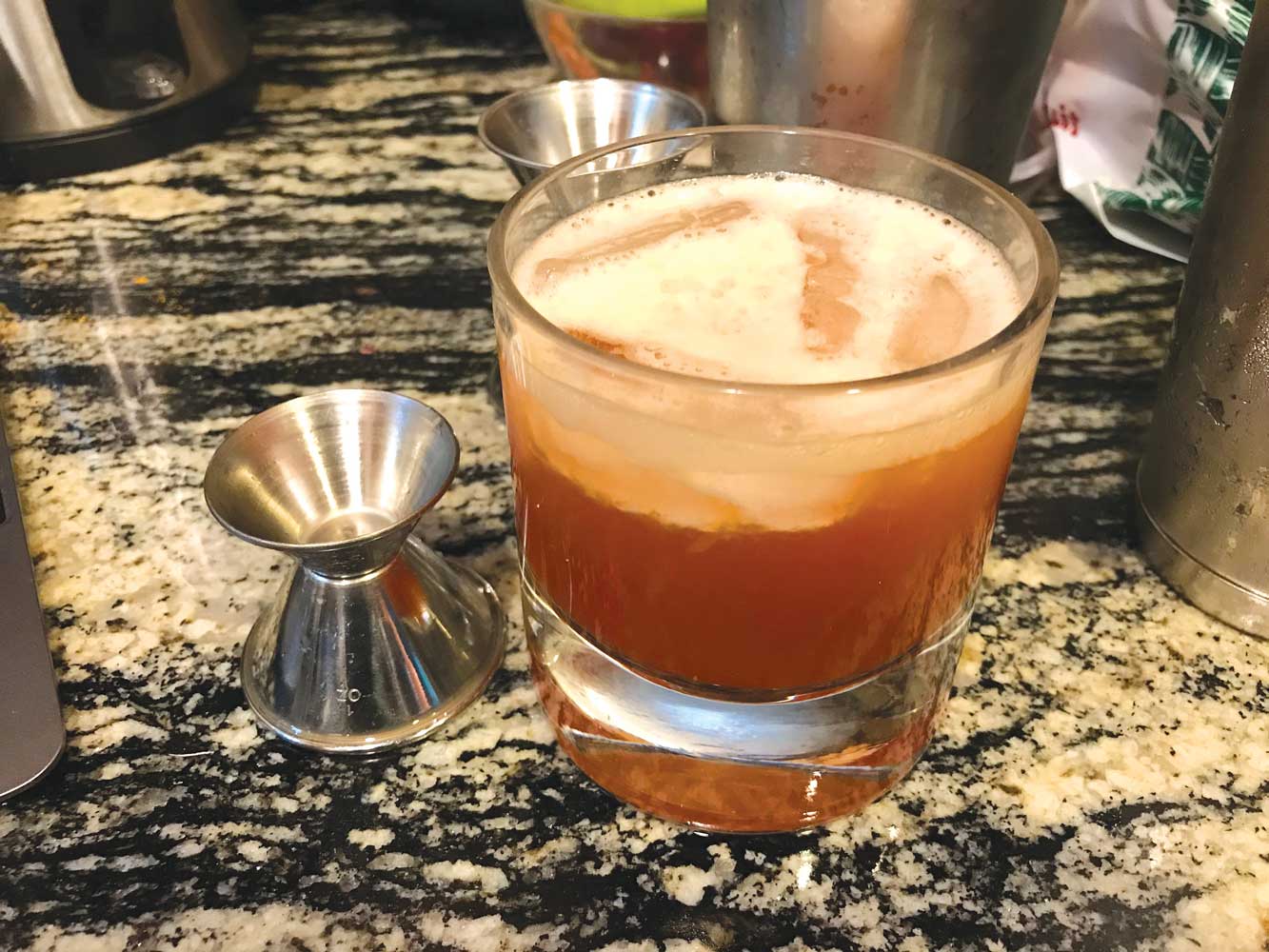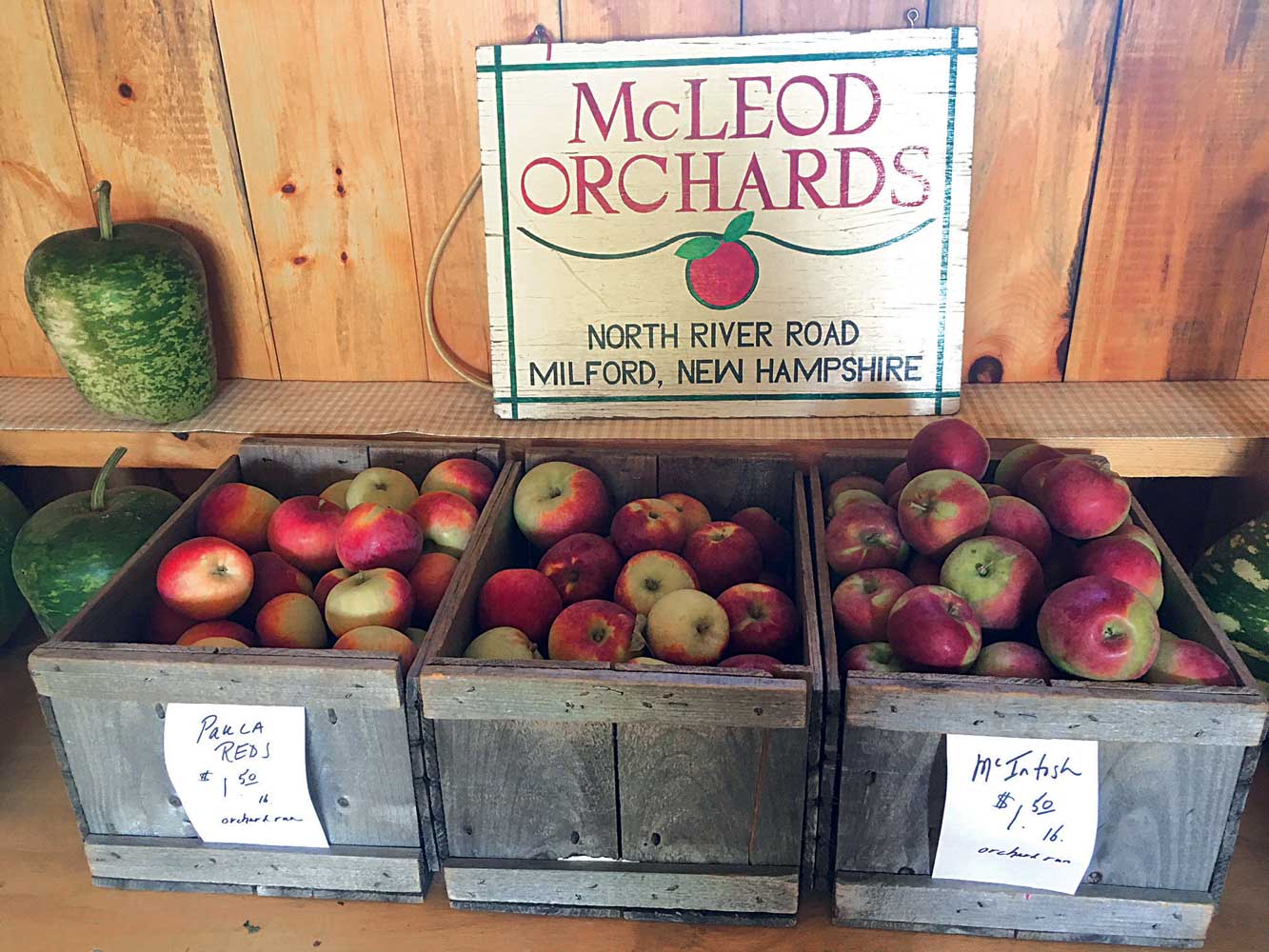Your guide to finding farm fresh apples and pumpkins
As Kris Mossey of McLeod Bros. Orchards in Milford was getting ready for the farm’s 75th season of pick-your-own apples, she was curious about what the turnout would be like. One week into its season, Mossey said, the orchard had its “busiest Labor Day ever,” and she couldn’t help but surmise it was due to more people staying close to home during the holiday weekend.
“We were pleasantly surprised,” she said. “I think everyone was just so happy to be able to get out with their families … [and] the blessing of pick-your-own apples is that we have plenty of space on the orchards for people to socially distance.”
September is prime apple and pumpkin picking season in New Hampshire, and even though some orchards and farms have had to do things a little differently, like eliminating samples and encouraging pickers to make reservations, there are still dozens of spots in the state to visit. Local apple and pumpkin growers talk about what the season has been like and what you should know when you come to the orchard.
Flavors of fall
According to Mossey, apple picking at McLeod Bros. Orchards began on Aug. 29 with Paula Reds, a mildly tart and juicy early season variety, before the McIntoshes and Cortlands, two of the most popular varieties, arrived about a week later. The McIntosh apple is known for its dark red color and very crisp flavor, making it a great apple for straight eating, while Cortlands have a firmness that makes them great for baking in pies and cakes. As the season moves through the end of September and into October, varieties like Galas, Mutsus, Jonagolds and Roxbury Russets usually become available.
A new feature to the orchard this year, Mossey said, is that pickers are encouraged to make reservations online if they plan to come in a group of six or more people. Simply visit the website and choose an allotted time slot at least 24 hours in advance. Masks are also required at the booth.
“It’s actually been very handy for us, because we know who is coming,” she said. “We’re also asking that just one person from each group comes up and gets their bag.”
In Merrimack, Currier Orchards opened for the season on Sept. 4. Joy Currier said about eight to 10 varieties are available throughout the season — they started with Honeycrisp, a very juicy and sweet variety, while others include Macoun, Gala, Red Delicious and Golden Delicious.
Samantha Fay of Sunnycrest Farm in Londonderry said the orchard is also currently picking Honeycrisp, Gala, McIntosh and Cortlands. During the week, pickers can purchase half-peck, peck or half-bushel-sized bags at the farmstand, while an outdoor booth is serviced on the weekends.
Fay said apples can last several weeks when refrigerated, or you can store them in a dry, cool area, though they will tend to soften up over time. If you’re going to be using them for baking at a later time, Fay said, they can be sliced and frozen.
Apple Hill Farm in Concord, which grows up to around 30 varieties of apples, according to co-owner Diane Souther, opened for apple picking on Sept. 5 with McIntoshes. Cortlands also became available last weekend and dozens more varieties will be ready come October.
Masks or face coverings are required when entering Apple Hill Farm’s store and interacting with staff, but once you purchase your bag and head out in the orchard, you’re allowed to take it off.
The farm also features around 20 different varieties of pumpkins in all sizes. Souther said the smaller, sweeter varieties — known as sugar pumpkins — do not tend to be as meaty or fibrous, and are thus better suited for baking and cooking.
Most pumpkins you’ll see at a farm or orchard that are labeled “field” or “carving” pumpkins are larger and work better if you’re making jack-o’-lanterns with them.
“Field pumpkins are the larger ones that are used for livestock feed … and then the sugar pumpkins are an edible pumpkin,” said Kitt Plummer of Hazelton Orchards in Chester, which opened for the season on Sept. 12 and offers all varieties of apples and pumpkins. “The field pumpkins are too stringy for [cooking]. Cows like them. People don’t.”
Rossview Farm in Concord, according to owner Don Ross, was scheduled to begin offering pumpkin picking out of its own patch this week. On Thursdays and Fridays from noon to 4 p.m. and on Saturdays and Sundays from 9:30 a.m. to 4 p.m., visitors will be able to enter the pumpkin patch and collect pumpkins from exactly where they grew.
“We do cut it off the vine for people, but otherwise the pumpkins are not moved,” Ross said. “I usually stay open until Halloween. …We do have a wash station right next to the farm stand where we ask people to wash their hands before they go into the patch and touch the pumpkins.”
If you’re keeping a watchful eye on them, Ross said pumpkins can easily last several months.
“As soon as it gets compromised by something, like one night of good frost, it’s going to slowly start decaying,” he said, “so if you have it out on your doorstep and you know there is frost coming, you can throw a blanket over it or bring it inside.”
Apple cake
Courtesy of Kris Mossey of McLeod Bros. Orchards in Milford
1 cup oil
1½ cups sugar
3 eggs
2 cups flour
1 teaspoon cinnamon
1 teaspoon baking soda
1 teaspoon salt
2 cups sliced apples
1 cup raisins
1 cup nuts
Mix oil, sugar, eggs, flour, cinnamon, baking soda and salt in a bowl, then add apples, raisins and nuts. Pour mixture into two greased 8-inch pans. Bake at 350 degrees for 35 to 45 minutes.
A season in drought
With the entire state experiencing either moderate or severe drought conditions as of Sept. 11, according to data from the U.S. Drought Monitor, New Hampshire apple and pumpkin growers have been faced with challenges that threaten to stunt the growth of their harvest.
It was also a very hot summer — in some communities, record-breaking. The city of Concord experienced its warmest summer in 144 years of record keeping this year, according to the National Weather Service, with 24 days of 90 degree or higher temperatures.
Warm and dry months of August are usually to be expected, but the extreme heat combined with the abnormal drought conditions has caused problems for some growers.
“We’ve had to irrigate a lot more than ever, because it’s been so dry, so a lot of the apples are much smaller than they usually would be,” Fay said of Sunnycrest Farm. “Some of the apples have been falling off the trees a lot quicker, which has also been an issue for us.”
Ross said although he too has had to perform a lot more irrigation on his pumpkins, his crop this year is still relatively healthy.
“I’m incredibly fortunate to have a very large water supply on my farm,” he said. “The amount of gallons of fuel I’ve had to use, though, has been astronomical compared to normal years.”
Overnight low temperatures moving forward usually determine how late in the season apple picking can last — for McLeod Bros. Orchards, this is usually around Oct. 20, according to Mossey, though if it continues to be warm enough, it can go a little bit longer.
“It’s always different,” she said, “but it’s normally later than the middle of the month, but not right at the end … and then it also depends on if we get picked out.”
Diane’s pumpkin apple crisp
Courtesy of Diane Souther of Apple Hill Farm in Concord
Peel and slice three to four medium-sized tart apples (enough to make three cups worth).
Apple layer:
⅓ cup brown sugar
1 tablespoon cornstarch
½ teaspoon ground cinnamon
¼ teaspoon salt
⅓ cup water (or sweet cider)
2 tablespoons butter
Stir the first five ingredients above and then add the two tablespoons of butter. Place on burner and bring to a slow boil, then add apples and cook and stir for four minutes. Turn off heat and let cool slightly while mixing up pumpkin mixture.
Pumpkin layer:
¾ cup pureed pumpkin (fresh or canned)
¾ cup heavy cream (or evaporated milk)
⅓ cup granulated sugar
1 egg
1 teaspoon cinnamon
1 teaspoon ground ginger
¼ teaspoon ground nutmeg
¼ teaspoon cloves
¼ teaspoon salt
Mix together above ingredients until smooth.
Crisp topping layer:
1 cup flour
1 cup dark brown sugar
½ to ¾ stick margarine or butter, slightly softened
1 teaspoon cinnamon
Mix above ingredients in a separate bowl until crumbly. In a 9-by-13 lightly sprayed pan, spread out the apple mixture from the saucepan. Pour the pumpkin layer over the top, then add the crisp topping. Bake at 350 degrees for approximately one hour, or until mixture is bubbly. Serve warm with vanilla ice cream on top.
Crockpot apple cider beef stew
Courtesy of Diane Souther of Apple Hill Farm in Concord
1½ to 2 pounds lean stew beef
2 slices of bacon
8 carrots, sliced thin
6 medium potatoes, sliced thin
2 apples, chopped (Cortland or Northern Spy varieties work well)
2 teaspoons salt
½ cup chopped onion
2 cups fresh apple cider
Cook the bacon slices in a saute pan, then remove and pat dry with a paper towel. Preserve bacon fat and saute the beef and chopped onion in it. Pat the beef dry and add to crockpot with remaining ingredients. Stir to mix, cover and cook on low for eight hours. Thicken juices with a flour and cold water mixture (about 1½ to 2 tablespoons of flour and 2 tablespoons of water).
Where to get farm fresh apples and pumpkins
Most of these southern New Hampshire farms will offer pick-your-own apples through the middle or the end of October, depending on weather conditions and availability. Some also offer a few varieties of field or sugar pumpkins, either pick-your-own or for sale at the farmstand. Do you know of a farm offering pick-your-own apples or pumpkins that isn’t on this list? Let us know at [email protected].
Apple Annie
66 Rowell Road E, Brentwood, 778-3127, appleannienh.org
What: Apples
Cost: $10 per half peck and $20 per peck
Days/times: Saturday and Sunday, 10 a.m. to 4 p.m. (by reservation only; visit the website)
Applecrest Farm Orchards
133 Exeter Road, Hampton Falls, 926-3721, applecrest.com
What: Apples and pumpkins
Cost: Apples are $30 per peck and $40 per half bushel; pumpkins are sold by the pound
Days/times: Daily, 8 a.m. to 6 p.m.
Apple Hill Farm
580 Mountain Road, Concord, 224-8862, applehillfarmnh.com
What: Apples and pumpkins
Cost: Apples are $15 per peck and $25 per half bushel; pumpkins range from 59 cents to $2, depending on the size and variety
Days/times: Daily, 9 a.m. to 5 p.m.
Appleview Orchard
1266 Upper City Road, Pittsfield, 435-3553, applevieworchard.com
What: Apples
Cost: $1.50 per pound
Days/times: Daily, 10 a.m. to 7 p.m.
Brookdale Fruit Farm
41 Broad St., Hollis, 465-2240, brookdalefruitfarm.com
What: Apples and pumpkins
Cost: Apples are $30 per half bushel or $1.50 per pound; pumpkins vary in cost depending on the size and the variety
Days/times: Wednesday through Friday, 10 a.m. to 5 p.m., Saturday and Sunday, 8 a.m. to 5 p.m.
Carter Hill Orchard
73 Carter Hill Road, Concord, 225-2625, carterhillapples.com
What: Apples and pumpkins
Cost: Apples are $6 per half peck, $12 per peck and $24 per half bushel; pumpkins range from $4 to $10, depending on the size
Days/times: Daily, 7 a.m. to 5:30 p.m.
Currier Orchards
9 Peaslee Road, Merrimack, 881-8864, find them on Facebook @currierorchards
What: Apples
Cost: $15 per 10-pound bag and $30 per 20-pound bag
Days/times: Tuesday through Sunday, 10 a.m. to 5 p.m.
DeMeritt Hill Farm
20 Orchard Way, Lee, 868-2111, demeritthillfarm.com
What: Apples and pumpkins
Cost: Apples are $5 per quarter peck, $17 per peck and $30 per half bushel; pumpkins range from $5 to $15, depending on the size
Days/times: Monday through Friday, 10 a.m. to 5 p.m., and Saturday and Sunday, 9 a.m. to 6 p.m.
Elwood Orchards
54 Elwood Road, Londonderry, 434-6017, elwoodorchards.com
What: Apples
Cost: $8 per half peck, $14 per peck and $24 per half bushel
Days/times: Daily, 9 a.m. to 4 p.m.
Gould Hill Farm
656 Gould Hill Road, Contoocook, 746-3811, gouldhillfarm.com
What: Apples
Cost: $12 per half peck and $18 per peck
Days/times: Daily, 10 a.m. to 5 p.m.
Hackleboro Orchards
61 Orchard Road, Canterbury, 783-4248, hackleboroorchards.com
What: Apples
Cost: $6 per half-peck, $10 per peck and $20 per half-bushel
Days/times: Daily, 9 a.m. to 6 p.m.
Hazelton Orchards
280 Derry Road, Chester, 493-4804, find them on Facebook @hazeltonorchardschesternh
Cost: Apples are $18 per peck and $28 per half-bushel. Pumpkins range from $3.50 to $8.50 apiece.
What: Apples and pumpkins
Days/times: Daily, 9 a.m. to 6 p.m.
J&F Farms
124 Chester Road, Derry, 437-0535, find them on Facebook @jffarms
What: Pumpkins
Cost: By the pound
Days/times: Monday through Friday, 9 a.m. to 6 p.m., and Saturday and Sunday, 9 a.m. to 5 p.m.
Kimball Fruit Farm
Route 122, on the Hollis and Pepperell, Mass., border, 978-433-9751, kimballfruitfarm.com
What: Apples
Cost: $1.25 per pound
Days/times: Daily, 9 a.m. to 7 p.m.
Lavoie’s Farm
172 Nartoff Road, Hollis, 882-0072, lavoiesfarm.com
What: Apples and pumpkins
Cost: Apples are $1.59 per pound; pumpkins are 59 cents per pound
Days/times: Daily, 8 a.m. to 7 p.m.
Lull Farm
65 Broad St., Hollis, 465-7079, livefreeandfarm.com
What: Apples and pumpkins
Cost: Apples are $15 per peck and $30 per half bushel; pumpkins are sold by the pound
Days/times: Daily, 7 a.m. to 6 p.m.
Mack’s Apples
230 Mammoth Road, Londonderry, 432-3456, macksapples.com
What: Apples and pumpkins
Cost: Apples are $15 per peck, $25 per half bushel and $45 per bushel (may be subject to change); pumpkins are 50 cents per pound
Days/times: Daily, 10 a.m. to 5 p.m.
McLeod Bros. Orchards
735 N. River Road, Milford, 673-3544, mcleodorchards.com
What: Apples
Cost: $15 per peck and $26 per half-bushel
Days/times: Monday through Friday, 1 to 5:30 p.m., and Saturday and Sunday, 10 a.m. to 5:30 p.m.
McQuesten Farm
330 Charles Bancroft Highway, Litchfield, 424-9268, find them on Facebook @mcquesten.farm
What: Pumpkins (Pick-your-own pumpkins from the hayrides will likely begin the week of Sept. 26; masks will be required for all riders)
Cost: Ranges from 49 cents to $2 per pumpkin, depending on its size and variety
Days/times: Saturday and Sunday, 10 a.m. to 4 p.m.
Meadow Ledge Farm
612 Route 129, Loudon, 798-5860, meadowledgefarm.com
What: Apples and pumpkins
Cost: Apples are $1.55 per pound; pumpkins are 59 cents per pound
Days/times: Daily, 9 a.m. to 6 p.m.
Rossview Farm
85 District 5 Road, Concord, 228-4872, rossviewfarm.com
What: Pumpkins
Cost: Varies, depending on the size and the variety of the pumpkin (starts at 50 cents per pound)
Days/times: Thursday and Friday, noon to 4 p.m., and Saturday and Sunday, 9:30 a.m. to 4 p.m.
Scamman Farm
69 Portsmouth Ave., Stratham, 686-1258, scammanfarm.com
What: Pumpkins
Cost: Ranges from 60 cents to $1 per pound, depending on the size and the variety of the pumpkin
Days/times: Tuesday through Friday, noon to 5 p.m., and Saturday and Sunday, 10 a.m. to 2 p.m.
Sullivan Farm
70 Coburn Ave., Nashua, 595-4560, find them on Facebook
What: Apples
Cost: $1 per pound
Days/times: Daily, 9 a.m. to 5:30 p.m.
Sunnycrest Farm
59 High Range Road, Londonderry, 432-7753, sunnycrestfarmnh.com
What: Apples and pumpkins
Cost: Apples are $8 per half peck, $15 per peck and $30 per half bushel; pumpkins vary in cost, depending on the size and variety
Days/times: Daily, 9 a.m. to 5 p.m.
Trombly Gardens
150 N. River Road, Milford, 673-0647, tromblygardens.net
What: Pumpkins
Cost: Costs are by weight, depending on the size and variety of the pumpkin
Days/times: Sunday through Thursday, 9 a.m. to 8 p.m., and Friday and Saturday, 9 a.m. to 9 p.m.
Featured Photo: McLeod Bros. Orchards in Milford. Photo by Matt Ingersoll.






